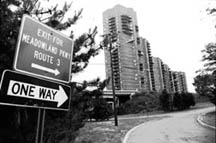When Mayor Dennis Elwell visited Panasonic’s Headquarters on Meadowlands Parkway earlier this month, the first thing he did was apologize. Apparently, the company had made several telephone calls to Town Hall complaining about large pot holes that had developed in the tarmac, risking damage to the vehicles of the hundreds of employees that come and go from the facility daily. “For some reason, their calls got ignored,” Elwell said. “That is outrageous. Someone should have asked the DPW to go down there and make those repairs. In the future, that’s what will happen. No one should call Town Hall and not get some kind of action.” In apologizing to officials at Panasonic, Elwell assured them that big plans are underway to repair the multi-lane roadway. This week, a critical study of the parkway was finished, sending the project into the next phase, said Town Administrator Anthony Iacono. “We needed to have the study in place before we put the project out to bid,” Iacono said. “This was a full study of the site, including boundary lines and helicopter photographs.” The work on the parkway – which the town was forced to take over as the result of a lawsuit settlement in 1998 – comes as a result of negotiations between the town of Secaucus, the Hackensack Meadowlands Development Commission, state and federal regulatory agencies and New Jersey Transit. The negotiations resulted in a $1.4 million grant for flood control and roadway improvements. “By combining the money we got from the Hartz settlement, we’re talking about some serious money,” Iacono said. “We estimate we’ll have about $1.6 million when we’re done.” NJ Transit gave the town the money to perform improvements on the Secaucus Transfer Rail Station, which is currently under construction and slated to open in less than two years. The funds also benefit residents of the Harmon Cove condominium development and employees of the various companies in the area – such as Panasonic. The parkway is a two-mile stretch of road connecting Route 3 and the southern sections of Secaucus and was built in the 1970s to accommodate truck traffic coming from the warehouses that dominated the area at the time. But as the warehouses became outlets, and residential properties such as Harmon Cove and facilities such as Meadowlands Hospital were built, the use of the parkway changed, opening it up more to public use and resulting in traffic levels never intended at the time of its construction. Potholes became routine because of the traffic and exposure to the elements. With the Hackensack River running close by, the parkway has sometimes been under water during high tides. To determine the exact level of work, the town council authorized a $77,000 survey of the parkway in anticipation of the improvement project. Included in this project, Iacono said, will be the bridge over the New Jersey Transit tracks that run along side Harmon Cove Towers. Tests done as early as 1996 showed inferior building materials under some sections of the road. While this met state standards for industrial parks, roadways serving the general public require a higher standard. Town officials said some parts of the road were built on meadows causing the road to sag in places. Rectifying this will likely require a reconstruction of the entire roadway, and the insertion of a “stabilizing material” to even out the roadbed. Officials said they would complete the project in stages and that the overall work will take up to eight months at an estimated cost of $2 million. To supplement the existing financial package, the town is seeking an additional $260,000 in grant money from the HMDC which would cover about half the cost of repairing the bridge where some of the concrete supports have been damaged by road salt over the years. The project would include adding a concrete deck area to the bridge, along with deck joints, drain replacement and a walkway railing. Elwell said the town used the same engineering firm for the study of the bridge that originally designed and constructed the bridge for Hartz Mountain Industries. “First and foremost, we have to replace the wooden walkway,” Elwell said. “It has rotted out and become dangerous.” Repairs to other roads connected to the Parkway may also be under consideration if funds are available, Elwell said.
Our Digital Archive from 2000 – 2016
